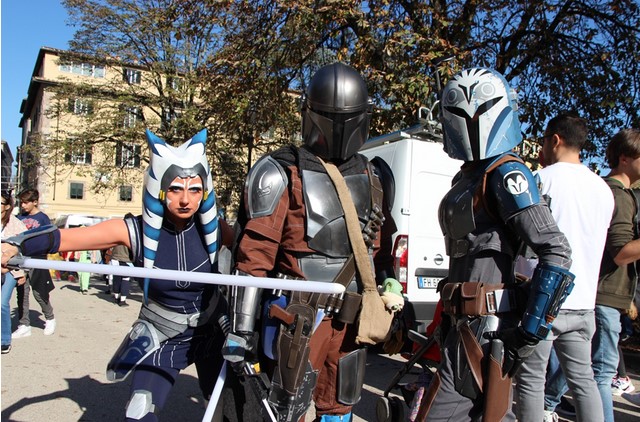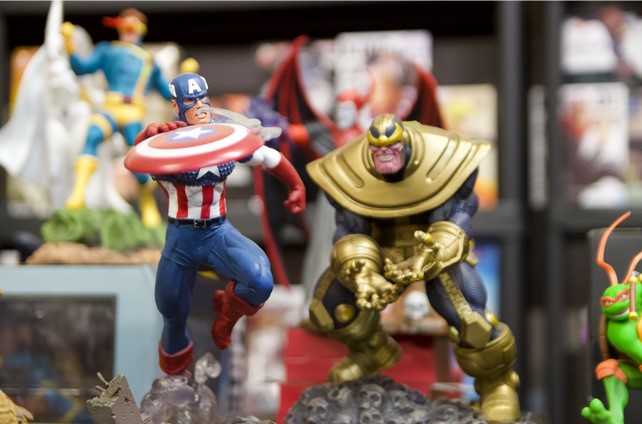In the world of pop culture, comics and graphic novels emerge as powerful educational tools, capable of telling complex stories and conveying profound values. From the origins of Italian comics to contemporary works, these narrative forms not only entertain, but also educate and preserve historical memory, stimulating dialogue on fundamental social and cultural issues.
Every year at the end of October, an Italian city is transformed into a giant stage surrounded by ancient 16th century walls. The autumn colours and ancient walls provide the perfect backdrop for a shot that immortalises Geralt of Rivia. It is not uncommon to see the Joker strolling arm in arm with Mickey Mouse.
We are talking about Lucca Comics & Games, the largest Italian festival dedicated to comics, animation, video games and pop culture. Founded in Lucca in 1966 as the Salone Internazionale del Fumetto, the festival has grown to become one of the most important events in the world.

Over the years, the event has broadened its horizons from comics to games conventions, integrating video games, animation, cosplay, fantasy and sci-fi. This has made Lucca a meeting place for fans of all ages, with events ranging from conferences and exclusive previews to exhibitions and workshops with world-famous artists and authors. Today, Lucca Comics & Games is a festival that attracts hundreds of thousands of visitors, giving prestige and visibility to a sector that is often undervalued but has an incalculable educational potential.

The origins of Italian comics
The first Italian comics date back to the early 20th century, inspired by American strips, and appeared mainly in magazines aimed at young people, such as the Corriere dei Piccoli (1908), a true precursor, which introduced episodic comics in Italy and showed an innovative narrative technique for the time, such as the separation of the images from the captions (the typical ‘nuvoletta’ was considered unsuitable for the Italian public). In the 1930s and 1940s a production of original stories developed, many of them inspired by American westerns and the adventure genre.
The Golden Age: Tex, Diabolik and the Italian classics
The 1950s and 1960s marked a golden age for Italian comics with the arrival of big names such as Tex Willer, who became the symbol of western comics in Italy; Diabolik (1962), created by sisters Angela and Luciana Giussani, represented a revolution in Italian comics: a dark, charismatic and ruthless anti-hero who defied the authorities and captured the popular imagination. This comic inaugurated the Italian noir genre, which was very successful in the 1960s.
Meanwhile, other authors such as Hugo Pratt with Corto Maltese (1967) took comics to a more artistic and intellectual level, exploring exotic locations and philosophical themes, and paving the way for a new kind of graphic storytelling.
The 1970s and 1980s: the rise of auteur and satire comics
In the 1970s and 1980s, Italian comics were enriched by innovative authors and more daring themes:
Andrea Pazienza became one of the best-known faces of Italian underground comics, with stories such as Zanardi and Pentothal, which reflected the malaise and contradictions of the youth of the time. Magazines such as Linus and Frigidaire helped to give visibility to a generation of innovative authors, hosting comics that dealt with political, social and cultural issues, often in a satirical or experimental style.
Comics and graphic novels: a new way of telling the world and history
Comics and graphic novels are visual formats that have the power to make complex issues accessible and appealing, especially to young people. This ability is based on the combination of images and text, which not only facilitates comprehension, but also makes reading more immersive, educating and raising awareness more effectively with a unique impact.
For example, in a graphic novel dealing with issues such as war, poverty or discrimination, the characters’ expressions, colours and stylistic choices can immediately evoke atmosphere or emotion. For young people, often accustomed to visual consumption of content (social media, video), this mode is attractive and natural.
An emblematic example is the comics of Zerocalcare, the pseudonym of Michele Rech, one of the best-known contemporary Italian cartoonists. With a unique style that mixes humour, social criticism and introspection, Zerocalcare has gained a wide audience, especially among young people, by addressing personal and social issues in a direct and visually appealing language. Among his most important works is Kobane Calling, a reportage that chronicles Zerocalcare’s travels to the Turkish Syrian border and then to Rojava, describing his encounters with Kurdish activists, volunteers and fighters. Through the story, Zerocalcare manages to convey the values of resistance and solidarity that characterise the Kurdish movement and the idea of the Rojava revolution, based on the principles of self-determination, gender equality and secularism.
One of the strengths of Kobane Calling is its ability to address the drama of war through empathetic storytelling, alternating moments of deep reflection with ironic and light-hearted scenes. This contrast between lightness and seriousness manages to capture the reader’s attention, making him or her better understand the complexity of a conflict situation without ever becoming moralistic or overly didactic.
Numerous comics and graphic novels deal with issues such as racism, immigration, mental illness, bullying and even violence. Art Spiegelman’sMaus, for example, uses the comic book format to narrate the Holocaust, a historical tragedy that can seem remote and difficult for a young person to fully comprehend and is often the subject of denialism. The depiction of Nazis as cats and Jews as mice manages to make the story more accessible while maintaining a strong emotional impact and helping readers reflect on discrimination and persecution.
Another very interesting product is ‘A Red Flower for Freedom’, a graphic novel that narrates the life and heroic deeds of one of the women who contributed to the liberation of Italy.
It is about the Florentine Liliana Benvenuti, whose battle name was ‘Angela’. She was about 20 years old when she enlisted in the ‘Arno’ Division and began her rearguard activity on a bicycle, risking her life every day to transport weapons and messages to her comrades in hiding.
‘I decided to tell her story because it is important to preserve the historical memory of that period, now that all those who lived through it are disappearing,’ explains author Thomas Pistoia. ‘The language of the comic (the drawings are by Emilio Guazzone) is an attempt to involve the new generations, children and teenagers, so that they realise how important freedom is, how easy it is to lose it and how difficult it is to regain it.’
Encouraging critical reflection
Graphic novels, such as Alan Moore’s V for Vendetta, do not simply tell a story, but encourage questions about the role of power, freedom and justice. Young readers are encouraged to reflect on these issues and consider their relevance in the real world. Storytelling can help develop a critical awareness that enables young people to question the values of the society in which they live.
Multimodal learning and inclusion
For many young people, especially those with learning difficulties or who are not used to traditional reading, comics represent a more inclusive access to literature. Multimodal learning can help overcome certain barriers and allow readers to follow complex stories and concepts with less difficulty, learning deep concepts without being overloaded by them.
Comics and graphic novels can then serve as catalysts for discussions about difficult topics. After reading stories such as Alison Bechdel’s Fun Home, which explores sexual identity and family conflict, young readers often feel a desire to share and discuss their thoughts, contributing to a broader social dialogue. As a format accepted and loved by young people, comics facilitate these conversations in an often less formal or ‘academic’ setting.
Ultimately, comics and graphic novels have proven to be powerful and versatile educational tools for introducing and exploring difficult topics with young people. They harness visual art to create empathy and understanding, fostering critical thinking and social awareness in a way that few other media can. As a narrative form close to them, comics and graphic novels manage to entertain and educate simultaneously, making them increasingly indispensable in today’s cultural and educational landscape.



